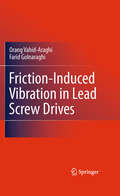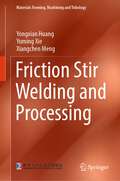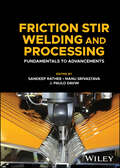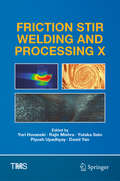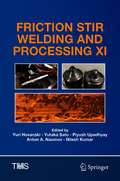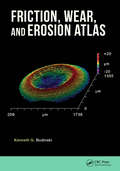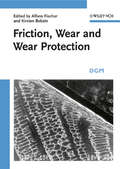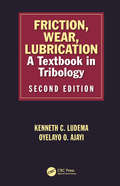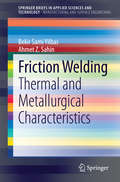- Table View
- List View
Friction at the Atomic Level: Atomistic Approaches in Tribology
by Motohisa HiranoWritten by one of the most distinguished scientists and a pioneer in this field, this monograph represents a stand-alone, concise guide to friction at the atomic level. It brings together hitherto widely-scattered information in one single source, and is the first to explain the nature of friction in terms of atomistic mechanisms. In addition to his detailed description on modeling and simulation, the author stresses experimental approaches like AFM (Atomic Force Microscope) techniques for verification of theory. In this respect the book will benefit the whole nanotribology community, from graduate students who want to get the basics right up to researchers specializing in mechanical engineering, materials science, physics and chemistry.
Friction Based Additive Manufacturing Technologies: Principles for Building in Solid State, Benefits, Limitations, and Applications
by Sandeep Rathee Manu Srivastava Sachin Maheshwari T.K. Kundra Arshad Noor SiddiqueeCurrently, most of the major commercial metal additive manufacturing (MAM) techniques rely on liquid phase processing. The liquid to solid phase transformations in these techniques results in microstructural issues and defects which in turn tantamount to inferior properties of fabricated build. Friction based additive manufacturing technologies are solid state processing techniques which work on the principles of friction based joining processes and layer by layer additive manufacturing. This book primarily addresses the basic understanding of seven friction based additive manufacturing techniques. These techniques include additive manufacturing methods based on rotary friction welding, linear friction welding, friction deposition, friction surfacing, friction stir additive manufacturing, friction assisted seam welding and additive friction stir. The principle of operations, benefits, limitations and recent developments of each technique has been described. It covers potentional and probable applications of each technique through review of various experimental studies. Features Targets friction based solid state additive manufacturing of metallic materials Describes principle of operation of seven friction based additive manufacturing techniques Reviews latest trends of these processes via experimental studies Describes benefits and limitations of each technique Covers current and probable applications of these techniques
Friction Based Additive Manufacturing Technologies: Principles for Building in Solid State, Benefits, Limitations, and Applications
by Sandeep Rathee Manu Srivastava Sachin Maheshwari T.K. Kundra Arshad Noor SiddiqueeCurrently, most of the major commercial metal additive manufacturing (MAM) techniques rely on liquid phase processing. The liquid to solid phase transformations in these techniques results in microstructural issues and defects which in turn tantamount to inferior properties of fabricated build. Friction based additive manufacturing technologies are solid state processing techniques which work on the principles of friction based joining processes and layer by layer additive manufacturing. This book primarily addresses the basic understanding of seven friction based additive manufacturing techniques. These techniques include additive manufacturing methods based on rotary friction welding, linear friction welding, friction deposition, friction surfacing, friction stir additive manufacturing, friction assisted seam welding and additive friction stir. The principle of operations, benefits, limitations and recent developments of each technique has been described. It covers potentional and probable applications of each technique through review of various experimental studies. Features Targets friction based solid state additive manufacturing of metallic materials Describes principle of operation of seven friction based additive manufacturing techniques Reviews latest trends of these processes via experimental studies Describes benefits and limitations of each technique Covers current and probable applications of these techniques
Friction-Induced Vibration in Lead Screw Drives
by Orang Vahid-Araghi Farid GolnaraghiFriction-Induced Vibration in Lead Screw Drives covers the dynamics of lead screw drives with an emphasis on the role of friction. Friction-induced vibration in lead screws can be the cause of unacceptably high levels of audible noise as well as loss of operation accuracy and shortened life. Although lead screw drives have a long history and their mechanical design and manufacturing aspects are very well understood, the role of friction in their dynamical behavior has not been comprehensively treated. The book draws on the vast body of work on the subject of dynamical systems with friction (such as disk brake systems) and offers said treatment, along with: · Unique coverage of modeling of multi-DOF lead screw systems with friction· Detailed analysis of negative damping, mode coupling, and kinematic constraint instability mechanisms in lead screws drives· A practical parameter identification approach for the velocity dependent coefficient of friction in lead screw drives Friction-Induced Vibration in Lead Screw Drives serves as the definitive text on the friction-induced vibration of lead screws, and includes a practical case study where the developed methods are used to study the excessive noise problem of a lead screw drive system and to put forward design modifications that eliminate the friction-induced vibrations.
Friction-Induced Vibrations and Self-Organization: Mechanics and Non-Equilibrium Thermodynamics of Sliding Contact
by Michael Nosonovsky Vahid MortazaviMany scientists and engineers do not realize that, under certain conditions, friction can lead to the formation of new structures at the interface, including in situ tribofilms and various patterns. In turn, these structures-usually formed by destabilization of the stationary sliding regime-can lead to the reduction of friction and wear. Friction-I
Friction Material Composites: Copper-/Metal-Free Material Design Perspective (Springer Series in Materials Science #171)
by K. L. SundarkrishnaaThis book examines material composites used in connection with brake friction, their design and safety. To aid in understanding, the essentials of friction are explained. This second edition was extended to include friction material composites without copper, as they offer an environmentally friendlier option. The second edition is intended to support beginners by offering insights into the essentials of friction material composites, helping them to develop a broader understanding of brake friction materials. Friction materials find wide-ranging applications in household and industrial appliances, brake pads for automotive applications, rail brake friction pads and composition brake blocks. This second edition is an introductory volume to a set of related books, and is based on the author’s experience and expertise with various material manufacturers, brake manufacturers, vehicle manufacturers, researchers and testing labs around the world with which the author has been associated for the past 28 years.
Friction Material Composites: Materials Perspective (Springer Series in Materials Science)
by K. L. SundarkrishnaaFriction Material Composites is the first volume of the five volumes which strongly educates and updates engineers and other professionals in braking industries, research and test labs. It explains besides the formulation of design processes and its complete manufacturing input. This book gives an idea of mechanisms of friction and how to control them by designing .The book is useful for designers of automotive, rail and aero industries for designing the brake systems effectively with the integration of friction material composite design which is critical. It clearly emphasizes the driving safety and how serious designers should select the design input. The significance of friction material component like brake pad or a liner as an integral part of the brake system of vehicles is explained. AFM pictures at nanolevel illustrate broadly the explanations given.
Friction Ridge Analysis: Applications of Nanoparticles for Latent Fingerprint Development (Materials Horizons: From Nature to Nanomaterials)
by Kumud Kant Awasthi Mahipal Singh Sankhla Sally Lukose Kapil PariharThe book presents emerging techniques for the development of latent fingerprint on various surfaces using nanotechnology. It explores the use of nanoparticles for the development of fingerprints. Various topics covered in this book include chemistry of nanomaterials for finger printing, quantum dots in fingerprinting, florescent nanoparticles in fingerprinting, nanocomposite and hybrid materials for fingerprints, carbon-based nanomaterial, silver and gold nanoparticles development of fingerprint, zinc oxide nanoparticles, silica nanoparticles for development of fingerprints, etc. Given the contents, the book will be highly useful for the students, researchers and professionals working in the areas of forensic science and nanotechnology.
Friction Stir Spot Welding: Metallurgical, Mechanical and Tribological Properties (Emerging Materials and Technologies)
by Jeyaprakash Natarajan K. Anton Savio LewiseFriction Stir Spot Welding offers an introduction to friction stir spot welding (FSSW) between both similar and dissimilar metals and materials. It explains the impact of the interlayer in FSSW of different metals with regard to mechanical, metallurgical, wear, thermo-mechanical, and chemical characteristics.Emphasizing the impact of interlayer on FSSW of different metals, this book discusses the influence of the interlayer in the process as a new technique. Using aerospace and automotive structures as examples, the book explains how their components successfully employ materials like dissimilar aluminium alloys, yielding increased electrical, thermal, and mechanical characteristics. It also considers the reinforcement, effect of tool geometry, wettability, and corrosion behavior of joints.This book is intended for mechanical, materials, and manufacturing professionals, researchers, and engineers working in the field of FSSW.
Friction Stir Spot Welding: Metallurgical, Mechanical and Tribological Properties (Emerging Materials and Technologies)
by Jeyaprakash Natarajan K. Anton Savio LewiseFriction Stir Spot Welding offers an introduction to friction stir spot welding (FSSW) between both similar and dissimilar metals and materials. It explains the impact of the interlayer in FSSW of different metals with regard to mechanical, metallurgical, wear, thermo-mechanical, and chemical characteristics.Emphasizing the impact of interlayer on FSSW of different metals, this book discusses the influence of the interlayer in the process as a new technique. Using aerospace and automotive structures as examples, the book explains how their components successfully employ materials like dissimilar aluminium alloys, yielding increased electrical, thermal, and mechanical characteristics. It also considers the reinforcement, effect of tool geometry, wettability, and corrosion behavior of joints.This book is intended for mechanical, materials, and manufacturing professionals, researchers, and engineers working in the field of FSSW.
Friction Stir Welding: Dissimilar Aluminium Alloys
by Noor Zaman Khan Arshad Noor Siddiquee Zahid Akhtar KhanThe evolution of mechanical properties and its characterization is important to the weld quality whose further analysis requires mechanical property and microstructure correlation. Present book addresses the basic understanding of the Friction Stir Welding (FSW) process that includes effect of various process parameters on the quality of welded joints. It discusses about various problems related to the welding of dissimilar aluminium alloys including influence of FSW process parameters on the microstructure and mechanical properties of such alloys. As a case study, effect of important process parameters on joint quality of dissimilar aluminium alloys is included.
Friction Stir Welding and Processing (Materials Forming, Machining and Tribology)
by Yongxian Huang Yuming Xie Xiangchen MengThis book introduces the principles and characteristics of friction stir welding and processing. Based on the inherent issues of friction stir welding, such as back support, weld thinning, and keyhole defects, the book summarizes innovative technologies related to solution strategies and presents a wide range of examples. It introduces the advantages and joining mechanism of friction stir welding in the joining of dissimilar materials and explains the importance of combining metallurgical bonding and mechanical joining. It also includes the characteristics of friction stir processing in terms of microstructure refinement, mechanical properties, surface modification, and the preparation of composites. This book is of interest to a broad readership in various fields of materials science and engineering.
Friction Stir Welding and Processing: Science and Engineering (The Minerals, Metals & Materials Series)
by Rajiv Sharan Mishra Partha Sarathi De Nilesh KumarThis book lays out the fundamentals of friction stir welding and processing and builds toward practical perspectives. The authors describe the links between the thermo-mechanical aspects and the microstructural evolution and use of these for the development of the friction stir process as a broader metallurgical tool for microstructural modification and manufacturing. The fundamentals behind the practical aspects of tool design, process parameter selection and weld related defects are discussed. Local microstructural refinement has enabled new concepts of superplastic forming and enhanced low temperature forming. The collection of friction stir based technologies is a versatile set of solid state manufacturing tools.
Friction Stir Welding and Processing: Fundamentals to Advancements
by Sandeep Rathee Manu Srivastava J. Paulo DavimA single source of information on the fundamental concepts and latest research applications of friction stir welding and processing Friction Stir Welding and Processing: Fundamentals to Advancements provides concise yet comprehensive coverage of the field of friction stir welding, with an eye toward future research directions and applications. Throughout the book, case studies provide real-world context and highlight applications for various engineering sectors. With contributions from an array of leaders in the field, Friction Stir Welding and Processing provides readers with a single source of information on all aspects of FSW and FSP. After explaining the fundamentals of friction stir welding (FSW) and its variants, the book discusses composite fabrication techniques using friction stir processing (FSP). Different types of friction techniques are covered, as is the equipment used. Detailed characterization of samples and composites are included. Additional topics discussed include the impact of FSW on the economics of production, methods for coupling FSW/FSP with additive manufacturing, composite fabrication, and process-property relationships. Master the basic concepts of friction stir welding and its variants Discover the role of FSW in developing hybrid manufacturing techniques Follow case studies that connect theoretical concepts to real-world experimental results Learn from contributions from an array of global thought leaders in the field This is a valuable compendium on the topic for engineers and designers who utilize welding and advanced manufacturing across industries, as well as graduate students and post-graduate researchers who are exploring new friction stir welding applications.
Friction Stir Welding and Processing: Fundamentals to Advancements
by Sandeep Rathee Manu Srivastava J. Paulo DavimA single source of information on the fundamental concepts and latest research applications of friction stir welding and processing Friction Stir Welding and Processing: Fundamentals to Advancements provides concise yet comprehensive coverage of the field of friction stir welding, with an eye toward future research directions and applications. Throughout the book, case studies provide real-world context and highlight applications for various engineering sectors. With contributions from an array of leaders in the field, Friction Stir Welding and Processing provides readers with a single source of information on all aspects of FSW and FSP. After explaining the fundamentals of friction stir welding (FSW) and its variants, the book discusses composite fabrication techniques using friction stir processing (FSP). Different types of friction techniques are covered, as is the equipment used. Detailed characterization of samples and composites are included. Additional topics discussed include the impact of FSW on the economics of production, methods for coupling FSW/FSP with additive manufacturing, composite fabrication, and process-property relationships. Master the basic concepts of friction stir welding and its variants Discover the role of FSW in developing hybrid manufacturing techniques Follow case studies that connect theoretical concepts to real-world experimental results Learn from contributions from an array of global thought leaders in the field This is a valuable compendium on the topic for engineers and designers who utilize welding and advanced manufacturing across industries, as well as graduate students and post-graduate researchers who are exploring new friction stir welding applications.
Friction Stir Welding and Processing IX (The Minerals, Metals & Materials Series)
by Yuri Hovanski Rajiv Mishra Yutaka Sato Piyush Upadhyay David YanThis books presents a current look at friction stir welding technology from application to characterization and from modeling to R&D. It is a compilation of the recent progress relating to friction stir technologies including derivative technologies, high-temperature applications, industrial applications, dissimilar alloy/materials, lightweight alloys, simulation, and characterization. With contributions from leaders and experts in industry and academia, this will be a comprehensive source for the field of Friction Stir Welding and Processing.
Friction Stir Welding and Processing VII (The Minerals, Metals & Materials Series)
This collection focuses on all aspects of science and technology related to friction stir welding and processing.
Friction Stir Welding and Processing VIII (The Minerals, Metals & Materials Series)
This collection focuses on all aspects of science and technology related to friction stir welding and processing.
Friction Stir Welding and Processing X (The Minerals, Metals & Materials Series)
by Yuri Hovanski Rajiv Mishra Yutaka Sato Piyush Upadhyay David YanThis book is a compilation of the recent progress on friction stir technologies including high-temperature applications, industrial applications, dissimilar alloy/materials, lightweight alloys, simulation, control, characterization, and derivative technologies. The volume offers a current look at friction stir welding technology from application to characterization and from modeling to R&D. Contributions document advances in application, controls, and simulation of the friction stir process to aid researchers in seeing the current state-of-the-art.
Friction Stir Welding and Processing XI (The Minerals, Metals & Materials Series)
by Yuri Hovanski Yutaka Sato Piyush Upadhyay Anton A. Naumov Nilesh KumarThis collection presents fundamentals and the current status of friction stir welding (FSW) and solid-state friction stir processing of materials, and provides researchers and engineers with an opportunity to review the current status of the friction stir related processes and discuss the future possibilities. Contributions cover various aspects of friction stir welding and processing including their derivative technologies. Topics include but are not limited to: • derivative technologies • high-temperature lightweight applications • industrial applications • dissimilar alloys and/or materials • controls and nondestructive examination • simulation • characterization
Friction, Wear, and Erosion Atlas
by Kenneth G. BudinskiFriction, wear, and erosion are major issues in mechanical engineering and materials science, resulting in major costs to businesses operating in the automotive, biomedical, petroleum/oil/gas, and structural engineering industries. The good news is, by understanding what friction, wear, or erosion mode predominates in a mechanism or device, you can
Friction, Wear and Wear Protection
by Alfons Fischer Kirsten BobzinThe proceedings collect invited and contributed papers from more than 150 scientists and engineers worldwide which provide an up-to-date overview of the current research on friction and wear, including new systematic approaches as well as innovative technical solutions.
Friction, Wear, Lubrication: A Textbook in Tribology, Second Edition
by Kenneth C Ludema Layo AjayiThe second edition of a bestseller, this book introduces tribology in a way that builds students’ knowledge and understanding. It includes expanded information on topics such as surface characterization as well as recent advances in the field. The book provides additional descriptions of common testing methods, including diagrams and surface texturing for enhanced lubrication, and more information on rolling element bearings. It also explores surface profile characterization and elastic plastic contact mechanics including wavy surface contact, rough surface contact models, friction and wear plowing models, and thermodynamic analysis of friction.
Friction, Wear, Lubrication: A Textbook in Tribology, Second Edition
by Kenneth C Ludema Layo AjayiThe second edition of a bestseller, this book introduces tribology in a way that builds students’ knowledge and understanding. It includes expanded information on topics such as surface characterization as well as recent advances in the field. The book provides additional descriptions of common testing methods, including diagrams and surface texturing for enhanced lubrication, and more information on rolling element bearings. It also explores surface profile characterization and elastic plastic contact mechanics including wavy surface contact, rough surface contact models, friction and wear plowing models, and thermodynamic analysis of friction.
Friction Welding: Thermal and Metallurgical Characteristics (SpringerBriefs in Applied Sciences and Technology)
by Bekir Sami Yilbas Ahmet Z. SahinThis book provides insight into the thermal analysis of friction welding incorporating welding parameters such as external, duration, breaking load, and material properties. The morphological and metallurgical changes associated with the resulting weld sites are analysed using characterization methods such as electron scanning microscope, energy dispersive spectroscopy, X-ray Diffraction, and Nuclear reaction analysis.


